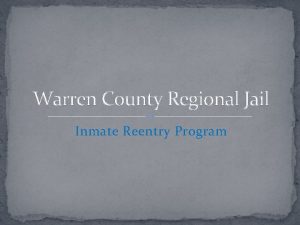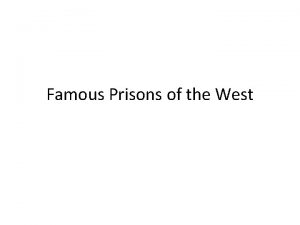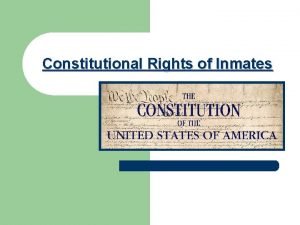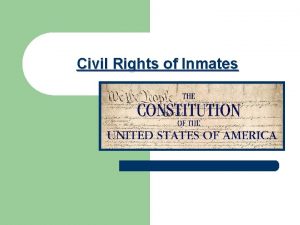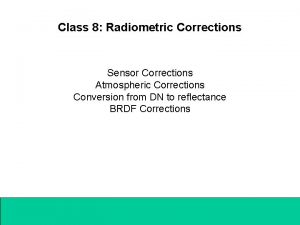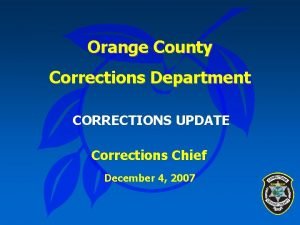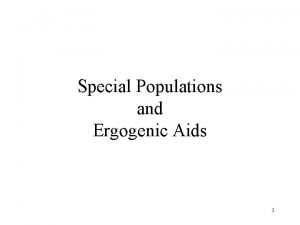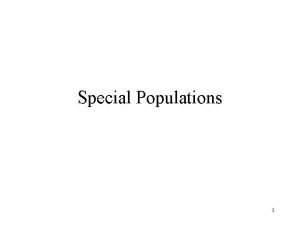Special Populations in Corrections CJS221 Special Population Inmates











- Slides: 11

Special Populations in Corrections CJS/221

Special Population Inmates Drug Addiction • Alcoholics • Drug addicts Sex Offenders • Child Molesters • Rapists Geriatric • Elderly population • Mental Health

Addicts Inmates who have drug offenses, or come into the prison system addicted to drugs or alcohol. This includes inmates that traffic drugs while incarcerated.

Drug Addict Concerns Trauma and Hopelessnessissues inmates have faced to bring them to the point of addiction. Gender Specific Issues Coerced Treatment Inmate Participation Staff Training

Sexual Offenders Inmates who are sentenced to prison for a sexual offenses. Rapists and child molesters are the largest population.

Sex Offender Concerns The child molester, faces had difficulties adjusting In many prisons, unless placed in protective custody, they are likely to be sexually assaulted or killed. Sex offenders have high rates of recidivism upon returning to the community.

Geriatric Offenders An aging offender or an elderly offender in an individual over the age of 55 who breaks the law or is in prison.

Geriatric Offender Concerns There are more than 120, 000 inmates age 50 and over. This number is sure to rise given the aging of the U. S. population and the get tough on crime measures in current sentencing Longer sentences make it harder for the elderly person to deal with confinement Vulnerable to victimization requires special attention in medical treatment, housing, nutrition, and institutional activities. Prisoners have much higher rates of cardiac disease, high blood pressure, hepatitis C, diabetes and other chronic diseases than the general population. Geriatric inmates are costly for the state.

Treatment Prison programs increasingly are informing inmates Some prison systems have worked with outside agencies programs designed to treat this special offense population

Diverse Corrections Staff Diverse corrections staff increases the sensitivity of the staff when dealing with inmates from different backgrounds and walk of life. Inmates can better relate to staff from their culture or backgrounds.

References Center for Substance Abuse Treatment for Adults in the Criminal Justice System. Rockville (MD): Substance Abuse and Mental Health Services Administration (US); 2005. (Treatment Improvement Protocol (TIP) Series, No. 44. ) 9 Treatment Issues Specific to Prisons. Available from: https: //www. ncbi. nlm. nih. gov/books/NBK 64123/ Center for Substance Abuse Treatment. Continuity of Offender Treatment for Substance Use Disorders from Institution to Community. Rockville (MD): Substance Abuse and Mental Health Services Administration (US); 1998. (Treatment Improvement Protocol (TIP) Series, No. 30. ) Chapter 6—Special Populations. Available from: https: //www. ncbi. nlm. nih. gov/books/NBK 64378
 703 kar 5:070
703 kar 5:070 Warren county ky jail commissary
Warren county ky jail commissary Edward oxford
Edward oxford Lpso codes
Lpso codes Siskiyou county jail bookings
Siskiyou county jail bookings Lpso lafayette
Lpso lafayette Famous prisoners in san quentin
Famous prisoners in san quentin Population ecology section 1 population dynamics
Population ecology section 1 population dynamics Chapter 4 population dynamics study guide answers
Chapter 4 population dynamics study guide answers Chapter 4 section 1 population dynamics answer key
Chapter 4 section 1 population dynamics answer key Population ecology section 1 population dynamics answer key
Population ecology section 1 population dynamics answer key Unraid write corrections to parity
Unraid write corrections to parity

